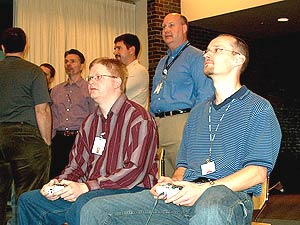|
Audio
Photos
|
 |
| Two engineers at IBM's Rochester plant take the Xbox 360 for a spin. The chip at the heart of the new gaming unit was developed in part in Rochester. (MPR photo/Sea Stachura) |
Rochester, Minn. — When you want an expert on Halo 2 or Perfect Dark Zero you might think you need to turn to a teenager. But it was the folks with the thick glasses and graying hair crowded around the xBox in IBM's cafeteria who really knew about the games.
Eric Mejdrich is a bit younger than most of his colleagues but he's in the thick of it. He says he started playing video games in 1984 with an early Nintendo system.
"I'm just a generic white male gamer," he laughs.
Mejdrich says he didn't get into engineering to work on video games. But he was one of the only engineers at IBM in Rochester who knew how to design graphics and game engines.
"Really a game machine is all about both the hardware and software," he says. "What sells a game machine is the software is the games. And so it's really a hardware software co-design problem. And so you have to understand how game engines work, how graphics work, how the artist pipeline works, in order to do the best job designing hardware to support that stuff."
Over 600 engineers worked on the computer chip worldwide. IBM's Xbox 360 program manager is Andy Schram. He says each gaming system has a unique chip that acts as its brain.
"We did something a little special for this in that we have three microprocessors on the same chip. Your computer at home most computers only have one. And Microsoft was very interested in building a new machine that would last for many years," he says.
Schram says the Xbox 360 is similar to IBM's supercomputer, Blue Gene, in that it has thousands of low-power processors tackling different problems. In the Xbox each processor deals with a separate component of the game: one for sound and one for graphics.
Eric Mejdrich says the third processor handles the player interaction details. And on Microsoft's Project Gotham Racing 3 those details are brand name vehicles and cityscapes that look like the real thing.
"There's reflections on painted surfaces," he says. "There are crowds. The crowds are all individually modeled people and they all react to cars bumping into walls where they're standing and the environments are some of the best environments I've seen in any game anywhere."
The graphics are designed with high definition television in mind. Schram says gaming is the way companies like Microsoft and Sony are gaining entry into people's homes. They hope consumers will then buy accessories to expand the unit into an entire home entertainment system. Schram says IBM has other goals.
"We see this as a way to generate large volumes for our manufacturing facilities, which reduces our costs in addition to producing real revenue," Schram says. "But from our standpoint it's really this is the driver for new technology so to some degree these games will allow us to build better IBM servers."
The Rochester Best Buy and Wal-Mart sold all 76 available Xbox 360s in a matter of minutes.
But as people munched cookies and played the 18 available games in the IBM cafeteria a few said they wouldn't have the time or the money for the $400 unit.
Or maybe they're just holding out for their next project: The Sony Play Station 3 due out next year.







